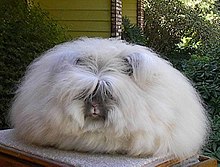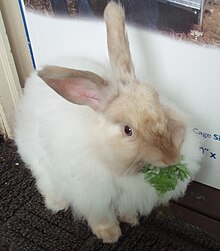Angora rabbit: Difference between revisions
Lunchscale (talk | contribs) m Reverted edits by 194.66.191.22 to last version by Darth Panda (HG) |
|||
| Line 11: | Line 11: | ||
There are four different [[American Rabbit Breeders' Association|ARBA]]-recognized Angora rabbit breeds: English, French, Giant and Satin. The German Angora is also common, but is not ARBA recognized. It has its own association; the [[IAGARB]]. |
There are four different [[American Rabbit Breeders' Association|ARBA]]-recognized Angora rabbit breeds: English, French, Giant and Satin. The German Angora is also common, but is not ARBA recognized. It has its own association; the [[IAGARB]]. |
||
it is a cool rabbit |
|||
=== English === |
|||
[[Image:Englishangora.jpg|thumb|An English Angora rabbit]] |
|||
*'''Weight:''' 2.0-3.5 kg (5-7½ lb). |
|||
*'''ARBA-accepted varieties:''' Ruby Eye White, Pointed White, Self, Shaded, Agouti |
|||
Prior to the 1939, there was one breed of "Angora Wooler". In 1939, ARBA reclassified "Angora Wooler" into "English Type" and "French Type". In 1944, ARBA officially separate Angora rabbit into two breeds: English Angora and French Angora. |
|||
Rabbits of the angora breed are adorned with "fur," growths of wool on the ears and the entire face except above the nose, and front feet, along with their thick body, and wool. They are gentle in nature, but they are not recommended for those who do not groom their animals. Their fur is very thick and needs to be groomed a lot. |
|||
This is the smallest Angora rabbit of the four breeds recognized by [[American Rabbit Breeders' Association|ARBA]]. This breed is more common as a pet because of the facial features that give it a puppy dog or teddy bear look. If the texture of the wool is correct, the maintenance is relatively easy; if the texture of the rabbit is [[cotton]]y, it requires a great deal of maintenance. |
|||
The English angora can be bred to have broken colors, (ex: the rabbit is white with black spots.) This is not accepted by ARBA standards and would lead to a disqualification when showing the rabbit. When showing an English angora rabbit the toe nails should also be only one color, the ears could be folded over at the tips, and the furnishings on the face may cover their eyes. |
|||
===French=== |
===French=== |
||
Revision as of 16:45, 17 November 2008
The Angora rabbit is a variety of domestic rabbit bred for its long, soft hair. The Angora is one of the oldest types of domestic rabbit, originating in Ankara, Turkey, along with the Angora cat and Angora goat. The rabbits were popular pets with French royalty in the mid 1700s, and spread to other parts of Europe by the end of the century. They first appeared in the United States in the early 1900s. They are bred largely for their long angora wool, which may be removed by shearing, combing, or plucking (gently pulling loose wool).
There are many individual breeds of Angora rabbits, four of which are ARBA recognized. Such breeds include French, German, Giant, English, Satin, Chinese, Swiss and Finnish, to name a few.

Coat, appearance, and personality
Angoras are bred mainly for their wool because it is silky and soft. Most are calm and docile, if given proper rest time, and should be handled carefully. Grooming is necessary to prevent the fiber from matting and felting on the rabbit. Because swallowed fur cannot leave their system, they should be groomed everyday or every other day.[citation needed] A condition "wool block" is common in angora rabbits and should be treated quickly. [1]Sometimes they are shorn in the summer as the long fur can cause the rabbits to herniate.
Breeds
There are four different ARBA-recognized Angora rabbit breeds: English, French, Giant and Satin. The German Angora is also common, but is not ARBA recognized. It has its own association; the IAGARB.
it is a cool rabbit
French

- Weight: 3.5-4.5 kg (7½-10 lb).
- ARBA-accepted varieties: Agouti, Pointed White, Self, Shaded, Ticked, Wide Band, and Broken.
This breed has a preponderance of guard hair on the surface, with wool as an undercoat. If the texture is correct, it requires less maintenance than other Angora breeds. Ear tufts are allowed but not preferred by breeders. The ARBA recognizes the same colors as with English Angora, plus broken. The French Angora is one of the largest Angora breeds at 7 1/2 to 10 lbs, with a commercial body type. It differs from the English and German Angora in that it possesses a clean face and front feet with only minor tufting on the rear legs.
German
- Weight: 2.0-5.5 kg (5-12 lb).
- IAGARB-accepted varieties: all (not subject to ARBA standards)
This breed, while not ARBA recognized, is common in the United States and Canada. It looks much like the Giant Angora, except it almost always comes in ruby-eyed white or albino. Many spinners breed the German Angora with another Angora breed for the bountiful German Angora wool in many beautiful colors. These Angora crosses are called hybrids.
Giant angoras were created in the United States using imported German angoras and also other large breed short haired rabbits. In a certain sense, a Giant is a cross-bred German. Many people confuse the Germans with Giants, which are only ruby eyed white.
A separate club for German angoras exists in the United States, caled the International Association of German Angora Rabbit Breeders, or IAGARB. Instead of conformation showing, the emphasis is on the wool bearing properties of the rabbit for commercial purposes. The rabbit must meet objective standards and perform well on 90 day shearing tests in order to be officially recognized as a registered German angora rabbit.
IAGARB, unlike ARBA, recognizes colored rabbits and a colored rabbit may achieve merit-based registration if it conforms to the standard and proves its wool bearing ability via the witnessed 90 day shearing tests. IAGARB also recognizes the worth of the rabbit based strictly upon its tests and judging, welcoming all breeds to test for registration status. It does not require breed purity.
Since IAGARB registration is independent of parentage, any colored angora rabbit that meets the registration standards of the club can be registered as a German Angora. The notion that they come only in white is a common misconception, as the rules have only recently been changed to include colored angoras as well as ruby eyed white.
Giant
- Weight: 4.5 kg (9½ lb) or larger
- ARBA-accepted varieties: Ruby-Eyed White
The Giant Angora is larger than other varieties of Angora, having been created to be an efficient wool rabbit on economical feed and housing. It has three hair types in its wool: underwool, awn fluff, and awn hair.
This is the largest of the four ARBA recognized Angora breeds. It produces more wool than the others in general. This breed may or may not have furnishings on the face and ears. In addition to the underwool and guard hairs, it has an "Awn Fluff" that does not exist in the other three breeds of Angora.
Satin

- Weight: 3.0-4.5 (6½-9½ lb).
- ARBA-accepted varieties: Agouti, Pointed White, Self, Shaded, Ticked, Wide Band
The Satin Angora is derived from a cross between a Satin and a French Angora. This breed is named for the extremely soft texture of its wool. It has no furnishings on face, ears, or feet, and it is also easy to groom compared to the English variety. Satin Angora's wool is said to be stronger for spinning than other varieties of Angora.
Spinners love the wool and sheen of this breed. However, this breed does not produce as much wool as other breeds of Angora rabbits. This trait is being improved upon by selective breeding. The wool should have a silky texture with good guard hair for ease of maintenance.
References
This article includes a list of references, related reading, or external links, but its sources remain unclear because it lacks inline citations. (February 2008) |
External links
- Angora Breeder Exhibitor in the UK
- National Angora Rabbit Breeders Club official website
- German Angora information, pictures, links to sites in Germany
- Home of Grand Champions Information on breeding, caring for, and showing Angora rabbits, as well as an extensive photo gallery.
- Spang Angoras Information on the French Angora Rabbit
- International Association of German Angora Rabbit Breeders official website
- Information on the humane breeding of Angora rabbits
